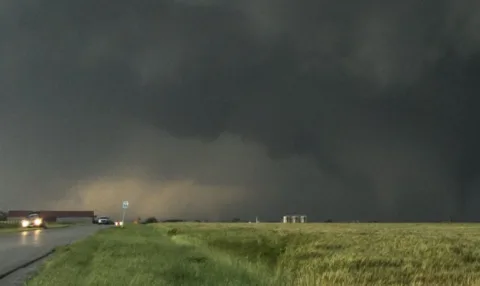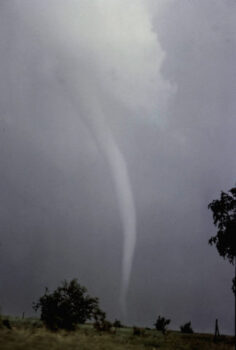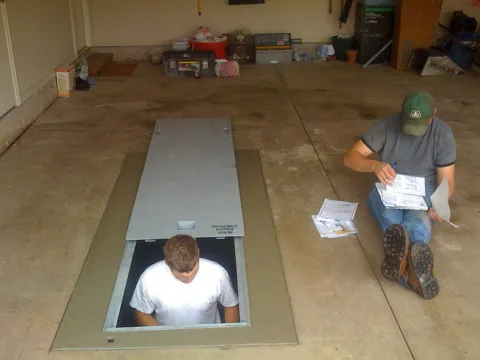Wondering if you live in Tornado Alley or not?
Tornado Alley isn’t an official region, per se. It’s a name that many people, including meteorologists, have used over the years to describe a huge swath of land spanning from northern Texas to Canada, centering around Oklahoma and Kansas.
That’s where powerful tornadoes touch down with high frequency as the weather warms during the late spring and early summer.
While tornadoes can occur at any time during the year just about anywhere, they are most heavily concentrated in certain states during the months of March, April, May, and June — although there is no official tornado season.
Which States Are In Tornado Alley?
Tornado Alley is a colloquial term that was first coined in 1952 to describe Texas, Oklahoma, and Kansas.
Over the decades, people have taken a liking to using the phrase “Tornado Alley” and generally now use it in relation to the following states:
- Texas
- Kansas
- Oklahoma
- South Dakota
- North Dakota
- Nebraska
- Iowa
- Missouri
- Arkansas
- Alabama
- Louisiana
- Illinois
- Indiana
- (Eastern) Colorado
- (Eastern) Wyoming
- (Western) Ohio
- (Western) Tennessee
- (Western) Kentucky
- (Western) Minnesota
The above states tend to fall into different alleys: Tornado Alley, Dixie Alley, Hoosier Alley, and Carolina Alley.
Interestingly, the state with the highest number of tornadoes each year per unit area, Florida, isn’t part of Tornado Alley.
The important distinction between the states in Tornado Alley and other places, such as Florida, is that many of the storms in the United States Midwest are quite severe and often unleash powerful tornadoes ranking EF 4 and EF 5 on the Enhanced Fujita Scale.
Florida tornadoes, on the other hand, are comparatively weak for the most part.
See how an older Tornado Alley map compares with an updated Tornado Alley map that includes Dixie Alley, Hoosier Alley, and Carolina Alley.
What To Do If You Live In Tornado Alley
If you happen to live in Tornado Alley — especially in areas like Oklahoma, Kansas, northern Texas, southern Nebraska, western Missouri, or western Arkansas — you need to take a few extra tornado safety precautions.
The first thing to know is the difference between a tornado watch and tornado warning:
- Tornado watch — A situation in which weather conditions are favorable for tornado development, but no tornado has been officially spotted on the ground or detected by radar. Be ready to evacuate to a safe spot.
- Tornado warning — A tornado has been spotted on the ground or indicated by radar. Seek safe shelter immediately.
So, what is considered safe shelter?
The best protection is a basement, storm cellar, underground tornado shelter, or interior safe room (a specially designed room usually constructed of metal).
If you don’t have a basement or storm shelter, the next best thing to do is seek refuge in an interior closet, hallway, or bathroom.
If you live in a region where severe weather frequently occurs, you should also:
- Review and discuss tornado preparedness plans with your loved ones.
- Make a tornado survival kit and keep it in a safe place, preferably where you will take shelter.
- Invest in a weather radio so you can stay on top of tornado alerts and other severe weather.
What NOT To Do If You Live In Tornado Alley
These are the things you should avoid doing:
- Don’t chase after a tornado. Yes, it’s true, there are storm chasers who spend their days hunting down tornadoes. They take their lives in their own hands every time they track down a storm. They also are very skilled at what they do and invest tons of money in the latest safety and storm tracking equipment. Bottom line? Don’t risk your life! Leave the cool storm photography and “hey-look-at-me-in-front-of-this-tornado” selfies to the professionals.
- Don’t take shelter under a bridge. Since 1991, a popular video has circulated showing a media crew taking shelter under an overpass as a tornado passes above. Not only was the tornado rather weak, but also the people in that video were very lucky… Tornado winds under an overpass usually create a very damaging wind tunnel effect, potentially injuring or killing individuals taking refuge there.
- Don’t think that a tornado can’t hit your neighborhood. The tragic Oklahoma City tornado of 1999 reminded people that tornadoes can even hit big cities. Twin tornadoes that struck Brooklyn and Queens, New York in 2012 further prove that no place is truly immune from tornadoes. In other words, don’t be complacent about tornadoes, and do be sure you have a tornado safety plan in place!
- Don’t be afraid of living in Tornado Alley. Many people live their whole lives in Tornado Alley and never have the misfortune of being injured or losing loved ones to severe weather. Tornadoes are powerful weather events that have hit every state in the nation and can occur anywhere. No place is really “safe” from tornadoes. So, if you take the proper precautions, you’ll increase your chances of enjoying a long, successful, and happy life in Tornado Alley.
Who Knew?… The United States sees more than 1,200 tornadoes per year, or 4 times more than in Europe.








